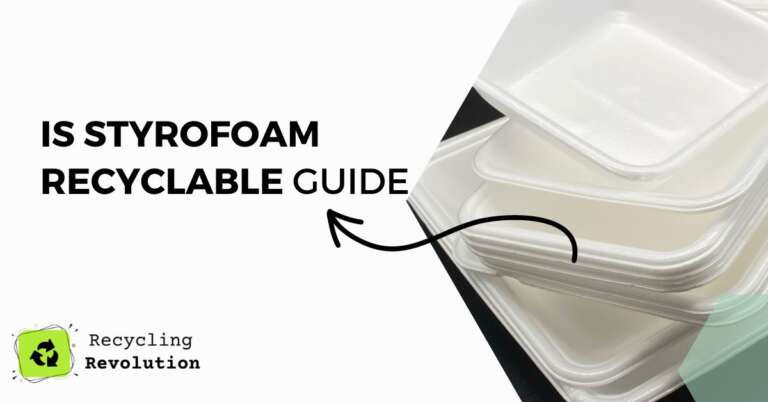You’re at a family barbecue, enjoying some tasty burgers and hotdogs. As the party winds down, you start cleaning up the leftovers and packing up the plates. Suddenly, you notice something that stops you in your tracks: a Styrofoam container from the store-bought meat. You don’t know what to do with it, so you toss it in the garbage.
But wait! Before you throw it away, did you know that Styrofoam is recyclable? In fact, it’s one of the most common materials that can be recycled. However, Styrofoam recycling is often overlooked, and as a result, this material ends up in landfills, oceans, and other places where it doesn’t belong.
What is Styrofoam?
First things first: let’s define Styrofoam. You might be surprised to learn that Styrofoam is actually a trademarked brand name for a type of polystyrene foam. It’s commonly used in food packaging, insulation, and disposable products like cups and plates.
Why is recycling important?
Recycling is important because it helps reduce waste and conserve resources. According to the Environmental Protection Agency (EPA), recycling one ton of plastic can save up to 3.8 barrels of oil, reduce greenhouse gas emissions by 2 metric tons, and save enough energy to power an average American home for 1.7 months.
The Problem with Styrofoam
The problem with Styrofoam is that it’s not biodegradable. This means that it doesn’t break down naturally over time, and it can take hundreds of years to decompose. When Styrofoam is disposed of improperly, it can release toxic chemicals into the environment and harm wildlife. According to the United Nations Environment Programme (UNEP), plastic waste is responsible for killing over one million seabirds and 100,000 marine mammals every year.
Styrofoam Recycling
The good news is that Styrofoam can be recycled! The process of Styrofoam recycling involves shredding the material into small pieces and melting it down into pellets. These pellets can then be used to make new products like insulation, picture frames, and more.
However, Styrofoam recycling can be a challenge. Because it’s so lightweight and bulky, it takes up a lot of space in landfills and can be difficult to transport. In addition, not all recycling facilities accept Styrofoam, so it’s important to check with your local recycling center to see if they offer this service.
Styrofoam Alternatives
If you’re looking for an alternative to Styrofoam, there are plenty of options out there. Biodegradable alternatives like paper or corn-based products can break down naturally and reduce waste.
Reusable options like glass or stainless steel can be used again and again, saving resources in the long run. And compostable alternatives like bamboo or wheat straw can be used for food packaging and then composted to enrich the soil.
More options
Plant-based materials such as cornstarch, potatoes, and wheat. Biodegradable foam is designed to break down naturally in the environment, reducing waste and pollution.
Another alternative is compostable packaging, which is made from materials like paper, sugarcane, or bamboo. These materials break down quickly in composting conditions, leaving behind no harmful residues.
Reusable containers made of glass, metal, or durable plastics are also an option to replace Styrofoam. These containers can be used multiple times and reduce the need for single-use packaging.
As consumers become more aware of the impact of single-use plastics on the environment, manufacturers are increasingly investing in the development of eco-friendly alternatives to Styrofoam. By choosing these alternatives, we can reduce waste and help protect the environment.
Environmental Impact of Styrofoam
The environmental impact of Styrofoam is significant. When Styrofoam ends up in landfills or the ocean, it can release toxic chemicals that harm wildlife and marine life. In addition, the manufacturing process for Styrofoam requires a lot of energy and produces greenhouse gases that contribute to climate change. According to a study by the American Chemical Society, the production of Styrofoam accounts for 2.3% of the world’s annual petroleum consumption.
Styrofoam Recycling in Different Countries
Styrofoam recycling is a global issue, and different countries have different approaches to this problem. In the United States, for example, Styrofoam recycling is not widely available, and many recycling facilities do not accept this material. However, some cities and states have implemented Styrofoam recycling programs, and there are private companies that offer Styrofoam recycling services.
In Europe, many countries have banned or restricted the use of Styrofoam in food packaging and other products. In Germany, for example, it’s illegal to use Styrofoam in food packaging, and many recycling facilities accept this material for recycling. In the United Kingdom, Styrofoam is not widely recycled, but there are some facilities that accept it for recycling.
In Asia, Styrofoam recycling is still in its early stages, but some countries like Japan have made significant progress in this area. In Japan, Styrofoam recycling is mandatory for businesses that generate a certain amount of Styrofoam waste, and the country has developed innovative technologies to recycle this material.
Top 10 Ideas For Reusing Styrofoam
Packing material: Use Styrofoam peanuts or sheets as packing material when shipping items. This will keep items safe during transit and reduce waste.
Art projects: Styrofoam can be used as a base for art projects, such as creating sculptures or models. It can be painted, cut, and shaped to fit your needs.
Insulation: Styrofoam can be used as insulation for homes, garages, or sheds. It is lightweight and easy to install.
Planters: Styrofoam can be used as a planter for indoor or outdoor plants. It provides insulation for the roots and helps retain moisture.
Floating devices: Styrofoam can be used to create floating devices for swimming pools or ponds. It can also be used to create flotation devices for boats or rafts.
Soundproofing: Styrofoam can be used as a soundproofing material in recording studios or music rooms.
Packaging for fragile items: Styrofoam can be cut and shaped to fit fragile items, such as glassware or electronics, to protect them during transport.
Halloween decorations: Styrofoam can be used to create spooky Halloween decorations, such as tombstones or skulls.
Seed starters: Styrofoam can be used as a seed starter for plants. Simply cut the foam into small pieces and use it to fill seedling trays.
Cleaning tools: Styrofoam can be used to create cleaning tools, such as scrubbers or sanding blocks. Cut the foam into the desired shape and use it to clean various surfaces.
Conclusion
In conclusion, Styrofoam recycling is an important issue that affects us all. By recycling Styrofoam, we can reduce waste, conserve resources, and help protect the environment. But Styrofoam recycling can be challenging, so it’s important to check with your local recycling center to see if they offer this service. And if you’re looking for an alternative to Styrofoam, there are plenty of options out there that can help you reduce waste and live a more sustainable lifestyle.
So, next time you come across a Styrofoam container, don’t just toss it in the trash. Consider recycling it instead and doing your part to help protect the planet. By making small changes in our daily lives, we can make a big impact on the environment and create a more sustainable future for all.
Remember, every little bit counts, and together, we can make a difference.
FAQ
Is Styrofoam actually recyclable?
Styrofoam is technically recyclable, but it is not widely accepted by recycling facilities due to its low market value and the difficulty in transporting and processing it.
What can I do with a large piece of Styrofoam?
If you have a large piece of Styrofoam, it’s best to try and reuse it if possible. You can also contact local recycling facilities to see if they accept Styrofoam for recycling or look for private companies that offer Styrofoam recycling services.
How do you dispose of Styrofoam?
If Styrofoam is not accepted for recycling in your area, it should be disposed of in the trash. It’s important to note that Styrofoam should never be burned as it releases harmful chemicals into the air.
Is Styrofoam biodegradable?
Styrofoam is not biodegradable and can take hundreds of years to break down in the environment. Instead of biodegrading, it breaks down into smaller and smaller pieces, which can harm wildlife and the environment.

